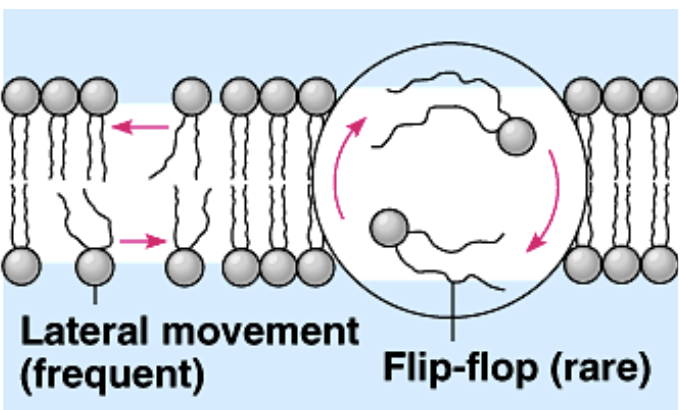Chapter 7: Membrane structure, osmosis, transport across membranes
1/55
Earn XP
Description and Tags
Lecture 9
Name | Mastery | Learn | Test | Matching | Spaced |
|---|
No study sessions yet.
56 Terms
What are the functions of the cell membrane?
Cell-cell recognition and communication involve specific molecules on cell surfaces
Regulate transport into and out of the cell
How do membranes regulate trasnport into and out of the cell?
Channels (Na+, K+, etc.), endocytosis
Cell-cell connections
What are some functions of membrane proteins?
Transport
Enzymatic activity
Signal transduction
Intercellular joining
Cell-cell recognition
Attachment to the cytoskeleton and extracellular matrix (ECM)
What does the extracellular matrix (ECM) do?
Helps the cell adhere and communicate
What are the general components of the ECM?
Proteins
Filaments of cytoskeleton
Carbohydrates
Glycolipids
Collagen
Fibronectin
What do integrins do on the ECM?
Bind outside ECM and transmit info from ECM to cytoskeleton inside
How are charged and larger/polar molecules transported across membranes?
Through hydrophilic membrane proteins that act as channels or as shuttles
Is transport selective/exclusive and unidirectional/bidirectional
Transport is selective and often unidirectional
How do small molecules transport across the membrane?
They easily flow through
What are two kinds of transport across membranes?
Passive
Active
What is passive transport?
Cell does not spend energy, down concentration gradient
What kind of molecules usually move passively across membranes?
Hydrophobic and small uncharged molecules
What is diffusion?
Transport of a solute down a concentration gradient
What is osmosis?
Transport of water down its concentration gradient
What are the two types of passive transport?
Diffusion
Osmosis
If diffusion stops at equilibrium, do molecules also stop moving?
No, at equilibrium, individual molecules do not stop moving, but their concentrations remain constant
How do solutes that are too large and can’t diffuse move?
Water molecules will move through the membrane to dilute more concentrated solute (OSMOSIS)
What are the relative measures of the ability for osmosis?
Hyperosmotic (hypertonic)
Isoosmotic (isotonic)
Hypoosmotic (hypotonic)
What is a hypotonic solution?
Concentration of solute is lower than the solution its being compared to (water moves in)
What is a hypertonic solution?
Concentration of solute is higher than the solution its being compared to (water moves out)
What is an isotonic solution?
The concentration of solute is same/equal to the concentration of the solution its being compared to (water flows equally)
Which way does water move in the selectively permeable membrane?
Water moves from lower to higher solution concentration (to dilute it)
How is osmosis characterized?
Osmotic pressure
Cells have many solutes that can’t diffuse through membranes and are hypertonic to pure water
What is osmotic pressure?
The tendency for a solution to take up water when separated from pure water by a selectively permeable membrane
How is osmotic pressure measured?
Measured in mOsm = sum of concentrations of all ions
What are the 3 types of cellular osmotic environment?
Animal cell
Hypotonic = lysed
Isotonic = normal
Hypertonic = shriveled
Plant cell
Hypotonic = turgid (normal)
Isotonic = flaccid
Hypertonic = plasmolyzed
What is facilitated diffusion?
An intermediate step between diffusion and active transport
Which way does facilitated diffusion move in a concentration gradient?
Moves down a concentration gradient (usually hydrophilic substances)
What facilitates facilitated diffusion?
Transport proteins
How does transport proteins function?
They function like enzymes
Bind specifically to transport substrate (cargo)
Exhibit saturation by transport substrate
What is active transport?
Works against a concentration gradient and requires energy
What is the sodium-potassium pump?
Type of active transport where cells have high concentrations of potassium ions and low concentrations of sodium ions
How does the sodium-potassium pump maintain its gradient?
By active export of sodium and import of potassium
What is the composition of the sodium-potassium pump?
Four-protein complex that spans the membrane
Binds 3 sodium ions inside the cell and receives energy by phosphorylation
Expels sodium ions to outside
Binds 2 potassium ions outside the cell → dephosphorylated to return to original conformation → release potassium ions inside cell → binds 3 ions of sodium
Causes hydrolysis of ATP → called sodium-potassium ATPase
What is the chlorine channel?
Ion transport channel regulated by phosphorlyation (cAMP dependent)
What do defects in the chlorine channel cause? What is the channel called?
Cystic fibrosis → CFTR = CF transmembrane conductance regulator
What is co-transport?
H+ gradient can drive another active transport, occurs through an ATP-dependent pump
How does co-transport increase membrane potential?
By removing protons
How are large molecules transported across membranes?
Phagocytosis
Pinocytosis
Receptor-mediated endocytosis
What is phagocytosis?
Non-specific engulfing and internalizing a particle
What is pinocytosis?
Non-specific extracellular fluid and dissolved substances are taken in
What is receptor-mediated endocytosis?
Specific internalization (the major type of transport of macromolecules across membranes)
How does receptor-mediated endocytosis work?
Macromolecules bind to a specific receptor on cell surface (coated pits)
Coated pits are coated with clathrin on the inner side of the membrane
Binding results in internalization and formation of transport vesicles (endosomes)
What are some examples of receptor-mediated endocystosis?
Uptake of cholesterol
Virus infenction of endocytosis (influenza)
What is the structure of a phospholipid?
Hydrophilic head, hydrophobic tail (one tail has a “kink” caused by double bond in unsaturated carbon)
What is a simple membrane?
Phospholipid bilayer
What is the fluid mosaic model of the phospolipid bilayer?
hydrophilic region of protein is outside, hydrophobic region is within

What does fluid mosaic mean?
Membrane lipids drift laterally and even “flip flop”
How are lateral movements of lipids visualized?
Fluoresence photobleaching
When do membranes solidify?
At low temperatures
What is the dual effect of cholesterol?
Cholesterol reduces fluidity at higher temperature and increases it at lower temperatures
What are membrane proteins made up of?
Integral and peripheral
What are integral proteins?
Proteins that are at least partly inserted into membranes; most completely span it (several times)
What are peripheral proteins?
Proteins that are attached to the membrane surface, but not inserted
What are transmembrane proteins?
Hydrophobic
Are biological membrane asymmetric or symmetric?
They’re asymmetric, their composition is different for inner and outer layers